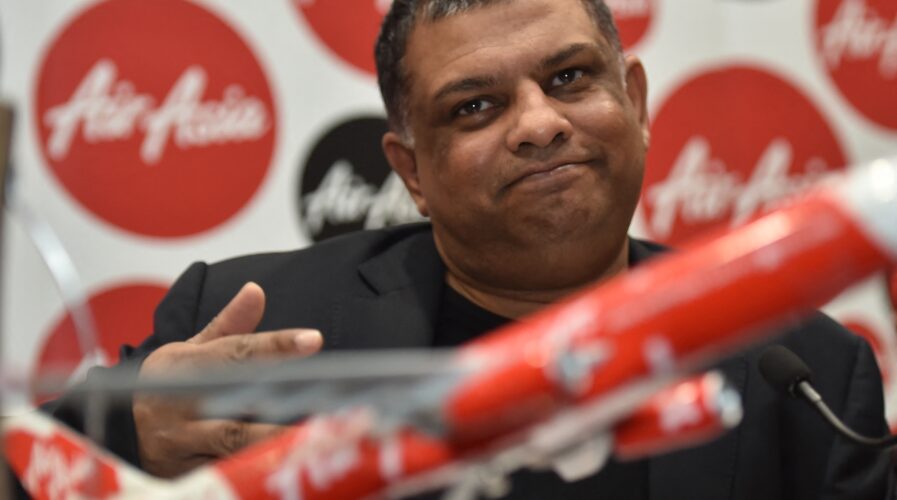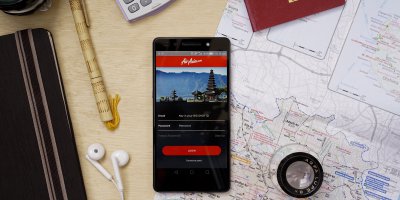
What’s next for AirAsia and its super app dreams? (Photo by PETER PARKS / AFP)
What exactly is AirAsia up to with its super app ambitions?
- After launching AirAsia Ride and AirAsia Food around Malaysia and Singapore, the low-cost airline does not intend to slow down on its super app dreams.
- AirAsia plans to “synergize” with Gojek to expand its super app services in Indonesia after taking over the latter’s Thailand business.
- The group believes it will take them only six months to outperform its competitors in the food delivery and ride-hailing business.
Over the last 18 months, airlines around have mostly been idle due to the travel restrictions worldwide. Naturally, airlines were quick to try and stop the cash bleed, but not many were innovative enough to find new ways to leverage their assets and revenue streams.
However, a low-cost airline in Asia — a region with a population of over 4.6 billion — decided to cash in on opportunities. AirAsia has been spreading its wings across Southeast Asia through its super app despite national lockdowns — and it doesn’t plan to slow down anytime soon.
The loss-making airline, controlled by business magnate Tony Fernandes, has most recently launched its ride-hailing and food delivery services across Malaysia as it adds more services to become one of Southeast Asia’s leading super apps. So far, the super app offers food delivery, ride-hailing, flight ticket booking, grocery shopping, and an e-commerce platform for beauty products.
The ride-hailing service is so far only made available in Kuala Lumpur and the broader Klang Valley area for now, although there are plans to expand to the rest of Malaysia. Meanwhile, its food delivery services — which AirAsia launched at the height of the pandemic last year — are in selected cities around Malaysia and north of Singapore.
The low-cost carrier also recently acquired Gojek’s ride-hailing and payments businesses in Thailand — signaling its fierce expansion into the region. The group has also made an acquisition of Malaysian online food delivery platform DeliverEat, which would allow the group to strengthen its fleet of drivers in Penang, an island city in Malaysia.
AirAsia super app’s head of commerce Lim Ben-Jie in a recent interview with Tech Wire Asia shared the group’s aspiration to grow beyond Malaysia, Singapore, and Thailand markets that its super app has gained ground in so far.
“Thailand was an easier expansion compared to Singapore because Gojek knew we were more experienced since we have been in the market for a longer time via the airlines. We have the sources, talent, data and our subsidiary, Teleport, is pretty strong there.”
As for Singapore, Lim attributed the slow start to AirAsia Food’s tech that was pretty nascent. “We were careful with our expansion, we wanted to go into the market fast. Only then we shifted our priority to improve the platform’s technology infrastructure. It is otherwise an easy market to enter and we are pretty confident about our future there.”
A few months later, AirAsia also launched a grocery delivery service in selected cities in Malaysia as well as Singapore with plans to expand more around both countries by the end of this year.
AirAsia Food: Newcomer vs big player
Truth be told, the delivery business market in Malaysia is a highly competitive one that’s dominated by popular and established stalwarts like GrabFood and Foodpanda. It was therefore a surprise to many to hear of AirAsia’s entry into the fray.
Looking at the bigger picture, ride-hailing giant Grab contributed nearly half of Southeast Asia’s food delivery gross merchandise value in 2020, hitting US$5.9 billion.
It also led five out of six of the markets in the region last year, according to a report by tech venture building firm Momentum Works. It was followed by food delivery service Foodpanda, with a GMV of over US$2.5 billion, and Gojek at US$2 billion.
Given these market conditions, one has to wonder what plans AirAsia has up its sleeve. Perhaps it is worth emphasizing that AirAsia intends to focus on small restaurants for its food delivery business. Charging lower commission fees (15%) than Foodpanda and Grab may help AirAsia onboard new and small restaurants, but the question of sustainability lingers.
“If you ask me would AirAsia Food survive? We would. Food is just one of our businesses and our core is still travel. Our diversification strategy, our infrastructure, and logistics are very ahead of the curve that’s why we are confident that we will make it through with these services,” Lim said.
To be precise, Lim, echoing the words of Fernandes, is pretty confident that in six months’ time, AirAsia Food and AirAsia Ride would surpass its competitors — a rather ambitious goal that they seem to have little doubt about. “ We are still a very young platform, so comparing us with Grab isn’t an ideal comparison, but as Tony said, give us six months, that’s all we need to have experiences that’s better than our competitors. That’s how ambitious we are.”
Without sharing exact figures, Lim told TWA that AirAsia Food is currently seeing two to three times monthly growth, fueled by expansions in more cities.
A collaboration with Gojek Indonesia?
While it is fair to flaunt AirAsia’s strong presence in Thailand, expanding its super app services may not be as easy elsewhere. In April this year, AirAsia’s super app launched its latest AirAsia Beauty product offering in both Malaysia and Indonesia.
“We have expanded our services so far in Malaysia, Singapore, and Thailand. Next, we plan to park our flags in the Philippines and Indonesia by the end of this year. These five countries are a priority because our presence there is very strong, so it is a quick win for us.” Lim said, adding that the goal is to spread across the ASEAN market by next year.
When it comes to Indonesia in particular, where Gojek’s super app is dominant, Lim iterated that AirAsia started by exploring categories beyond what the Indonesian-grown app offered. Hence, AirAsia beauty first, in Indonesia.
He then further highlighted that there is something in the works with Gojek and AirAsia as it is necessary for the latter to synergize with the former in order to penetrate into Southeast Asia’s biggest economy. “We will definitely synergize and in terms of competing, there is definitely going to be something we (AirAsia and Gojek) will do together in that market,” he told TWA.
Lim reckons synergizing is a necessary step in certain markets. “It depends on the market. When we bought the Gojek business in Thailand, we knew we had strengths in that country but we do not have the same advantage in Indonesia. It’s different — they (Gojek) are stronger there so we need to see how we can complement our businesses together, side by side.”
Despite it all, AirAsia has been in the red for seven consecutive quarters, posting a net loss of RM767.4 million (US$182 million) in the first quarter this year. Nevertheless, the group’s aggressive expansion of its super app footprint in ASEAN and its ambition to become the region’s “challenger super app”, may just be a game-changer not to AirAsia alone but to the airline industry as a whole.
After all, Fernandes has reiterated one too many times that AirAsia is now a multi-business company and a very valuable data-driven technology company with a strong brand.
So it is worth seeing if the goal to have its non-airline revenues match and then surpass airline revenue can be achieved eventually.
READ MORE
- The criticality of endpoint management in cybersecurity and operations
- Ethical AI: The renewed importance of safeguarding data and customer privacy in Generative AI applications
- How Japan balances AI-driven opportunities with cybersecurity needs
- Deploying SASE: Benchmarking your approach
- Insurance everywhere all at once: the digital transformation of the APAC insurance industry


